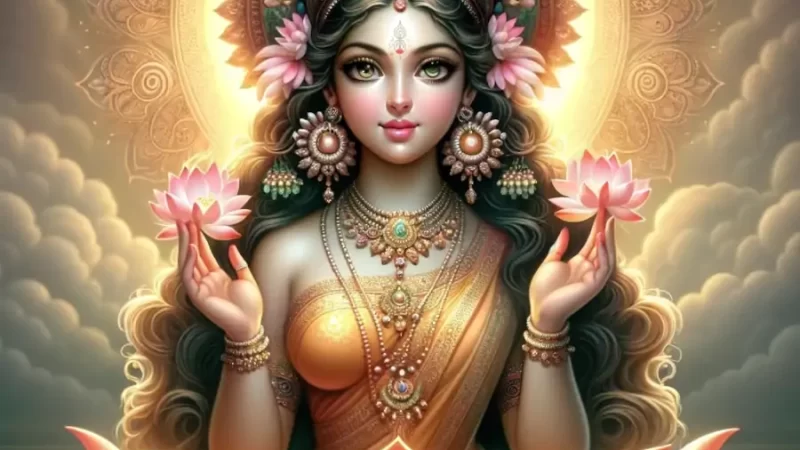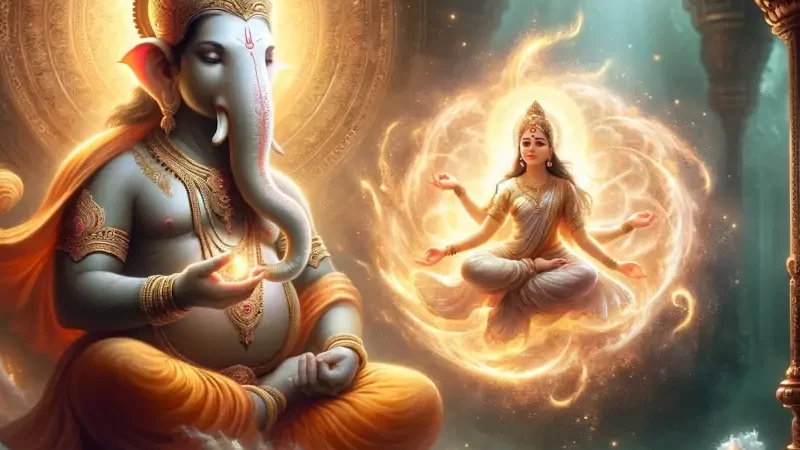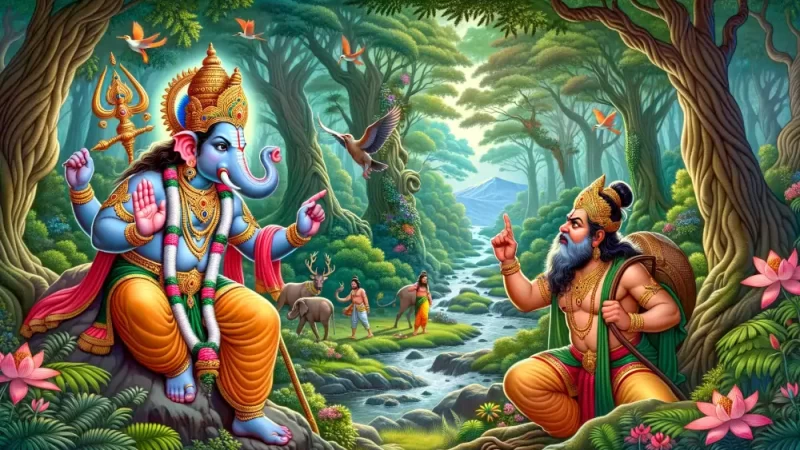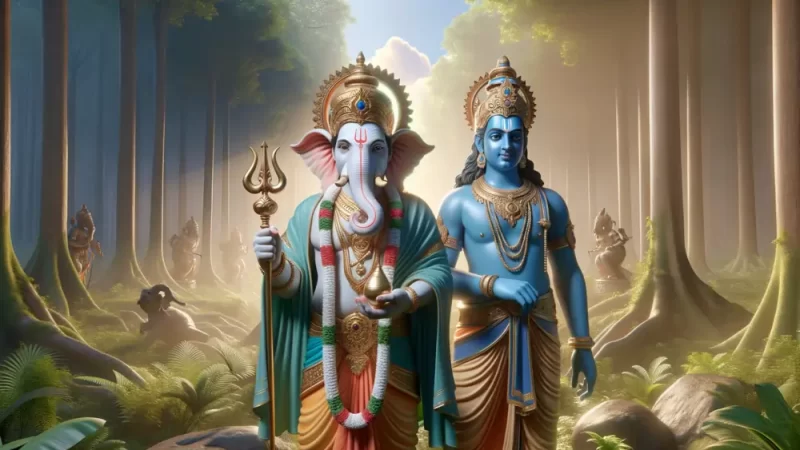Lord Ganesha’s Broken Tusk: A Symbolic Tale of Sacrifice and Wisdom
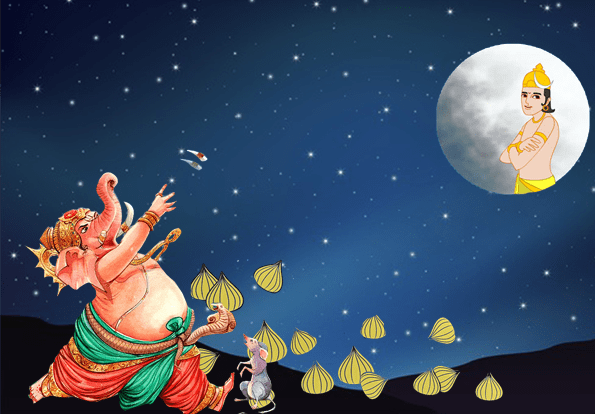
The Tale of Lord Ganesha’s Broken Tusk
In the vibrant tapestry of Hindu mythology, Lord Ganesha stands as a beloved deity, revered as the remover of obstacles and the bestower of wisdom. Yet, there exists a fascinating story that delves into the origin of his distinctive feature—a broken tusk. This captivating tale unfolds on a moonlit night, filled with a mishap, a curse, and an enduring lesson.
A Sumptuous Feast Fit for a Deity
Our story begins on a night of celestial revelry, as Lord Ganesha finds himself returning from a lavish feast hosted by Kubera, the god of wealth and abundance. The opulent spread had delighted Ganesha’s palate, with his favorite Modakas, delectable sweets made of rice, coconut, and sugar, among the culinary delights.
Ganesha, with his characteristic elephant head and potbelly, rode upon his trusty mount, a mouse, making their way homeward under the shimmering light of the full moon. The moon, resplendent and flawless, cast its luminous glow upon the earth, bathing everything in its ethereal radiance.
A Fateful Encounter with a Serpent
As Ganesha and his mouse ambled along their moonlit path, fate intervened in the form of a serpent. The slithering creature, dark and sinuous, suddenly crossed their path, causing the mouse to tremble in fear. Startled by the snake’s unexpected appearance, Ganesha was jolted from his perch atop the mouse.
The Tumultuous Tumble and the Scattered Sweets
In the ensuing chaos, Ganesha tumbled to the ground, his rotund form spilling the Modakas he had relished onto the earth. The sweets, round and delicious, scattered like stardust, a cosmic offering to the ground beneath.
A Swift Recovery and a Clever Solution
Swiftly, Ganesha gathered the precious Modakas that had tumbled from his pouch. Determined not to let the delectable treats go to waste, he placed them back into his pouch. However, there remained a quandary—how to keep them secured and prevent further mishaps.
In a stroke of ingenious creativity, Ganesha seized the serpent that had caused the disturbance and wound it around his plump belly, cinching it tight like a celestial belt. The snake, now an unconventional guardian, would ensure that the Modakas remained safely tucked away.
The Amused Moon and a Playful Retort
Having regained his composure and secured his Modakas, Ganesha turned his attention to the sky. What he beheld above him was Chandra Deva, the moon, gazing down upon the scene with twinkling amusement. Chandra Deva, with his luminous visage, seemed to find humor in Ganesha’s misadventure and could not contain his laughter.
Ganesha’s Embarrassment and Swift Reaction
Ganesha, however, was not amused by the moon’s mirth. He felt a flush of embarrassment at having been witnessed in such a vulnerable moment. A wave of irritation surged within him, and in a moment of spontaneous action, he decided to respond to Chandra Deva’s amusement.
The Broken Tusk and the Birth of “Ekadanta”
In a display of divine temper, Lord Ganesha, with a deft movement, broke off one of his own tusks. This sudden act of self-mutilation was both a reaction to his embarrassment and a swift retort to the moon’s laughter.
Holding the broken tusk in his hand, Ganesha flung it toward Chandra Deva, who watched in astonishment. This act not only silenced the moon but also left Lord Ganesha with a distinctive feature—a broken tusk. Henceforth, he came to be known as “Ekadanta,” the Single-Tusked Lord.
The Curse and the Lesson
However, the story does not end with the broken tusk. Ganesha’s actions also carried consequences for Chandra Deva, the moon. In his irritation, Ganesha pronounced a curse upon the moon, decreeing that it would disappear from the sky, never to show its face again.
Chandra Deva’s Pleading and Ganesha’s Blessing
Frightened by the severity of the curse, Chandra Deva beseeched Lord Ganesha for mercy and forgiveness. Ganesha, in his benevolence, could not revoke the curse but chose to mitigate its effects. He granted Chandra Deva a modified fate—the moon would wane and wax in a recurring cycle.
According to Ganesha’s blessing, Chandra Deva would slowly diminish in appearance, leading to a night of no moon, followed by a gradual increase in size until it reached its full luminance on the fifteenth day—a cycle that continues to this day.
The Enduring Legacy of Lord Ganesha’s Wisdom
The tale of Lord Ganesha’s broken tusk serves as a poignant reminder of the divine being’s wisdom and the profound lessons that can be drawn from even the most unexpected circumstances. In his quick-witted response to embarrassment, Ganesha imparts a message about the importance of self-acceptance and the ability to transform adversity into uniqueness.
Furthermore, the story illustrates the compassion of Lord Ganesha, who, despite pronouncing a curse, bestowed a merciful blessing that has since shaped the lunar phases we witness in the night sky. It is a testament to the multifaceted nature of this beloved deity and the enduring legacy of his wisdom.
Interested to read more about Lord Ganesha stories?


